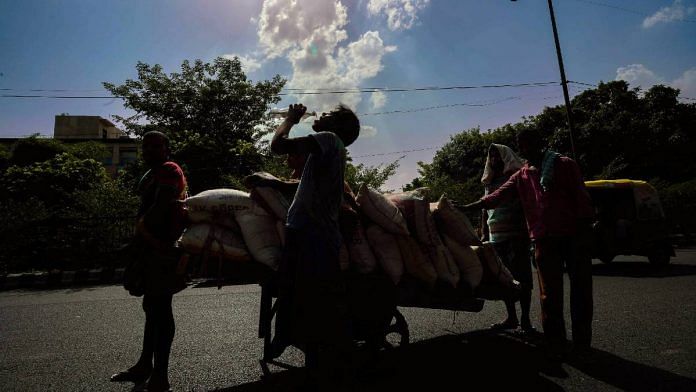New Delhi: The chatter around extreme heat has introduced a new term to our climate change vocabulary — wet bulb temperatures. As heat wave conditions set in across the subcontinent for the second time this month, concerns around wet bulb temperatures — a measure of both heat and humidity — and their effects on human health have also surfaced.
In February this year, an Intergovernmental Panel on Climate Change (IPCC) report on climate vulnerability and adaptation had stated that if emissions are not drastically reduced, wet-bulb temperatures would creep closer and closer to 35 degrees Celsius, broadly considered the upper limit of human survivability. Prolonged exposure to 32 degrees can make outdoor activity debilitating.
Densely populated agricultural regions in South Asia — such as the Gangetic plains and Indus river basins — are particularly vulnerable, the IPCC report stated.
Other research papers have found that instances of extreme humid heat have increased in more recent decades, and that the 35-degree threshold was exceeded for the first time in 2017.
While humidity does play a role in how heat impacts human health, and the occurrence of extreme humid heat is becoming more frequent, experts say the prospects of wet bulb temperatures reaching 35 degrees for a prolonged period — at which point it becomes lethal — are still slim.
The factors influencing human survivability are more complex and go beyond just temperature and humidity. According to experts, the more urgent focus should be on mitigating the effects of extreme heat on vulnerable communities.
Also read: Global met. body almost certain that one year between 2022 & 2026 will be hottest on record
What is a wet bulb temperature?
Wet bulb temperatures are measured by wrapping a wet cloth on a thermometer and observing the temperature at which evaporation occurs. This is distinct from the more commonly known ambient or dry temperature, which is measured as is.
“When the water starts evaporating from the cloth, the temperature in the thermometer begins to decrease. How much evaporates depends on the humidity. The wet bulb temperature will be high if humidity is also high, but will be cool if there are dry conditions with lots of evaporation,” explained R. Krishnan, a climate scientist with the Indian Institute of Tropical Meteorology, Pune.
With every one-degree rise in the global mean temperatures, there is a 7 per cent increase in humidity, the IPCC report had said, indicating that higher temperatures and higher levels of humidity in the atmosphere have already set in. Since pre-industrial times, global temperatures have risen by 1.1 degrees celsius.
How does extreme heat affect human bodies?
Extreme heat — whether dry or humid — is dangerous for human health. When it’s hot, the body begins to perspire as a means to cool down. But at high wet bulb temperatures, when both heat and humidity are high, sweat won’t evaporate, making it difficult for the body to cool.
Theoretically, at a 35-degree wet bulb temperature, prolonged exposure could be fatal even for a healthy person, because there is no way for the body to adapt to the heat.
“At very high dry temperatures, it’s easy for the body to get dehydrated, because you lose a lot of water through sweat,” said Dr Abhiyant Tiwari, a Gujarat-based heat health expert. If exposure is constant, dehydration can lead to more extreme symptoms, like delirium and death. “But it’s equally dangerous if your body can’t cool down, because it can cause our internal thermodynamic balance to fail,” he added.
Heatwaves killed 24,380 people in India between 1991 and 2018, according to the National Disaster Management Authority (NDMA). However, the extent to which humidity influenced these deaths has not been not well studied.
Why 35-degree wet bulb temperatures are unlikely to last long
The same paper that found the 35 degree threshold had been crossed, also said that it did so for “only for 1-to 2-hours’ duration”, and has “not yet occurred at the regional scale”. (It was recorded at certain weather stations, which can’t be extrapolated for whole regions.)
According to climate scientists, it is extremely difficult for such a high wet bulb temperature to endure, given high humidity levels trigger thunderstorm-like conditions.
“The level of humidity required for a 35-degree wet bulb temperature isn’t even typically found on the ocean surface. If it does occur, it’s usually for a short period of time before a thunderstorm. One or two hours doesn’t constitute prolonged exposure,” said Joy Merwin Monteiro, assistant professor with the department of earth and climate science at the Indian Institute of Science Education and Research (IISER), who is studying the effect of heatwaves on human health.
“Another important point to note is that people die of heat strokes at wet bulb temperatures that are much lower than 35 degrees, too, because there are other physiological and social factors that play a role in vulnerability,” he pointed out.
Krishnan, too, agreed that extremely high wet bulb temperatures are unlikely to endure.
“Some of these projections are based on scenarios where greenhouse gas emissions are extremely high, so it’s important to keep that in mind,” he said.
Extreme heat is, however, still a problem, and one that is likely to get worse with climate change. Surviving heat risk depends on several factors, including access to shelter and water and medical history, among others. The elderly and poor, who are more likely to suffer comorbidities or be constrained by their economic status, are among the most vulnerable.
“Heatwaves are treated like a one-time disaster, but vulnerability to heat is pre-determined, and those factors need to be addressed first. All the things we need to do to reduce heat vulnerability, like improving our social systems, have co-benefits. It needs to be a year-long process, with adequate funds and implementation,” said Dr Neethi Rao, a health systems researcher and consultant with the World Health Organization.
(Edited by Poulomi Banerjee)
Also read: India’s heat risk interventions still new. Heatwave in 2022 shows it needs to learn fast



